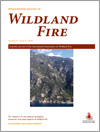International Journal of Wildland Fire
Volume 27
Number 8 2018
We describe the growing wildfire problem in Greece and demonstrate that large wildfires will not be mitigated by existing risk governance owing to scale mismatches and the lack of cohesive risk governance. We propose prioritising the protection of communities and highly valued resources though vegetation management, based on transboundary, biophysical risk assessments with wildfire behaviour modelling.
Weather radar stations are designed for monitoring rain, but are also able to detect smoke plumes from wildfires. Strong quantitative relationships exist between the rate of growth of fires and the radar-detected plumes above them. Weather radar could be a valuable tool for monitoring wildfires, particularly at times of limited visibility.
We used weather radars to estimate the height and areal footprint of 223 large-particle plumes from prescribed and wild fires in south-eastern Australia. Wildfire plumes were much higher and had larger areal footprints than prescribed fires, even for fires of the same area burnt. The width of plume from both fire type was greatest at the base of the plume. Plume height and areal footprint were strongly influenced by area burnt and the height of the planetary boundary layer.
Because of highly variable individual fire sizes, commonly used statistics for estimating expected fire size are insufficient to explain the entire range of fire impacts, which is required for better management planning. Quantile regression is proposed as an alternative technique to obtain probabilistic characterisations of fire size distributions to support fire ecologists and managers.
A three-dimensional (3-D) mathematical model of the fuel bed ignition by glowing particles originating during wildland fires is proposed. In order to test and verify the model, a series of experiments was conducted to determine the fuel bed ignition time by a single glowing pine bark and pine twig firebrand.
Fire-prone environments often contain species that are adapted to fire. However, fire is not uniform in an environment. This study suggests that populations of Erica coccinea living on fire-free islands have different responses to fire than populations of the same species living in the surrounding fire-prone area.





